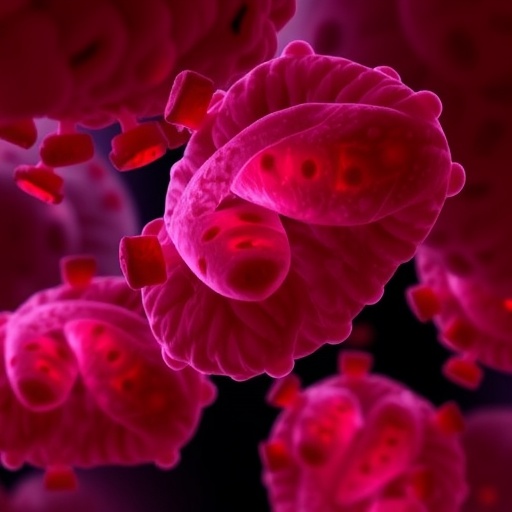In a groundbreaking revelation within the realm of microbiology and immunology, a team of researchers led by Zhang, Y., Xu, C., and Zhong, HM, has uncovered how infection by the notorious bacterium Helicobacter pylori can significantly downregulate the expression and secretion of microRNA-223 (miR-223) in neutrophils. This discovery, set to be published in International Microbiology, highlights the intricate interactions between pathogenic bacteria and the host’s immune response, shedding light on novel pathways that could influence therapeutic strategies against H. pylori infections.
H. pylori is a well-documented opportunistic pathogen, primarily affecting the gastric mucosa and contributing to various gastrointestinal diseases, including peptic ulcers and gastric cancer. Despite its long-recognized affiliation with these conditions, the underlying molecular mechanisms by which it modulates host immune processes remain poorly understood. The research by Zhang et al. addresses this critical gap by focusing on the role of miR-223, a small non-coding RNA that plays a pivotal role in regulating inflammation and immune responses.
MicroRNAs are integral to the regulation of gene expression, affecting various biological processes, including apoptosis, differentiation, and the immune response. Among them, miR-223 has emerged as a significant player in neutrophil biology, where it influences neutrophil maturation, survival, and inflammatory responses. The research team hypothesized that H. pylori infection could interfere with miR-223 expression, subsequently affecting neutrophil behavior and function. Their meticulous investigations revealed that H. pylori indeed downregulates the expression of miR-223, leading to altered neutrophil activation states.
What does this mean for our understanding of inflammatory processes? By elucidating the relationship between H. pylori and miR-223, this research underscores a crucial immunomodulatory mechanism. The dampening of miR-223 levels in neutrophils seems to lead to a more prolonged and potentially uncontrolled inflammatory response. This dysregulation contrasts with the typical role of miR-223, where it serves to restrain excessive neutrophil activation and, consequently, tissue damage due to inflammation.
In light of these findings, it is essential to reflect on the potential clinical implications. Helicobacter pylori infection is global in scope, with billions of individuals infected worldwide, many of whom remain asymptomatic yet at increased risk for severe gastrointestinal conditions. Understanding how miR-223 is modulated during infection could open new avenues for therapeutic interventions aimed at restoring normal miRNA levels and mitigating inflammation. Therapeutics that target the modulation of miR-223 could represent a novel strategy for managing H. pylori-related diseases.
The research team employed an array of techniques, including quantitative PCR and Western blot analysis, to assess miR-223 expression in neutrophils from infected patients. What became apparent from their findings is that even in the presence of inflammatory stimuli, the levels of miR-223 were compromised in the context of H. pylori infection. This raises further questions about how H. pylori manages to manipulate host cellular machinery to establish a favorable environment for its persistence.
Furthermore, the research also investigated the downstream effects of miR-223 dysregulation, revealing that the downregulation leads to a cascade of effects on various pro-inflammatory cytokines and chemokines. As neutrophils serve as one of the first lines of defense during infection, understanding H. pylori’s ability to exploit these immune cells gives critical insight into chronic inflammation’s contribution to pathogenesis in the gastric mucosa.
It is crucial to recognize that the implications of Zhang et al.’s study extend beyond H. pylori. The principles unveiled regarding miRNA regulation and the host-pathogen interaction might also be applicable to various bacterial pathogens, potentially leading to broader insights into bacterial manipulation of the immune response.
Moreover, ongoing research efforts will need to examine how these findings translate into larger populations and diverse patient demographics. The dynamic interplay between microbiota and the immune system can differ markedly among individuals, influenced by genetic, dietary, and environmental factors.
In summary, Zhang, Y., Xu, C., and Zhong’s research marks a pivotal moment in understanding how bacterial infections shape immune responses at the molecular level. The downregulation of miR-223 in neutrophils delineates a sophisticated mechanism through which H. pylori alters local immune dynamics, potentially contributing to chronic disease outcomes. As the scientific community delves deeper into the role of microRNAs in host-pathogen interactions, it becomes increasingly clear that these small molecules may hold the key to unlocking new therapeutic modalities for combatting chronic infections and inflammation.
This exciting research also opens up further avenues for exploration, such as the relationship between miR-223 and other forms of gastrointestinal pathology, and whether manipulating miR-223 could also affect responses to other pathogens. With further validation, the potential exists for miR-223 to serve not only as a biomarker for H. pylori infection but also as a target for novel interventions that could enhance host resistance to infection or reduce the risk of progression to more severe disease states.
As we move forward, the integration of such findings into clinical practice may revolutionize approaches to managing H. pylori infections and associated diseases—an undeniable advance in the field of microbiology and translational medicine.
Subject of Research: The impact of Helicobacter pylori infection on miR-223 expression in neutrophils.
Article Title: H. pylori infection downregulates the expression and release of miR-223 in neutrophils.
Article References: Zhang, Y., Xu, C., Zhong, HM. et al. H. pylori infection downregulates the expression and release of miR-223 in neutrophils. Int Microbiol (2025). https://doi.org/10.1007/s10123-025-00660-9
Image Credits: AI Generated
DOI: https://doi.org/10.1007/s10123-025-00660-9
Keywords: Helicobacter pylori, microRNA, miR-223, neutrophils, immune response, inflammation, gastrointestinal diseases, pathogenic bacteria.




